HR Professional Skills: CPID, Group Dynamics, Conflict Resolution Plan
VerifiedAdded on 2023/06/12
|26
|4978
|377
Report
AI Summary
This report delves into the essential aspects of becoming a successful Human Resource professional, utilizing the CPID model to assess strengths and weaknesses. It emphasizes the evolving role of HR managers, who must be agents of change, administrative experts, and effective problem-solvers. The report identifies areas for improvement, particularly in personal credibility, role modeling, and curiosity. Furthermore, it explores group dynamics and conflict resolution techniques, highlighting their importance in HR practice. The analysis culminates in a personal development plan, incorporating insights from the CPID assessment and SWOT analysis, to guide career progression and ensure success in the HR field. Desklib offers a variety of resources, including solved assignments and past papers, to support students in their academic and professional development.
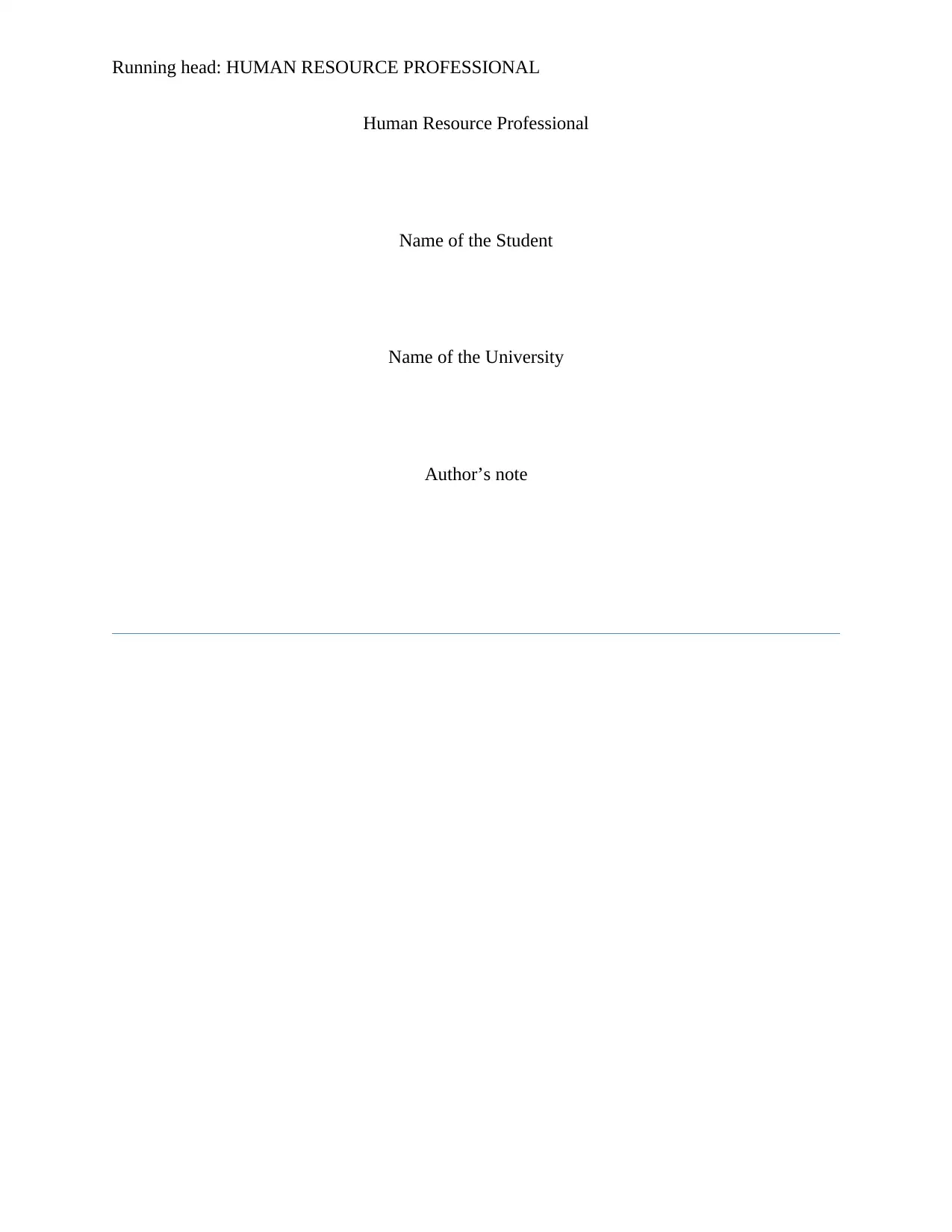
Running head: HUMAN RESOURCE PROFESSIONAL
Human Resource Professional
Name of the Student
Name of the University
Author’s note
Human Resource Professional
Name of the Student
Name of the University
Author’s note
Paraphrase This Document
Need a fresh take? Get an instant paraphrase of this document with our AI Paraphraser
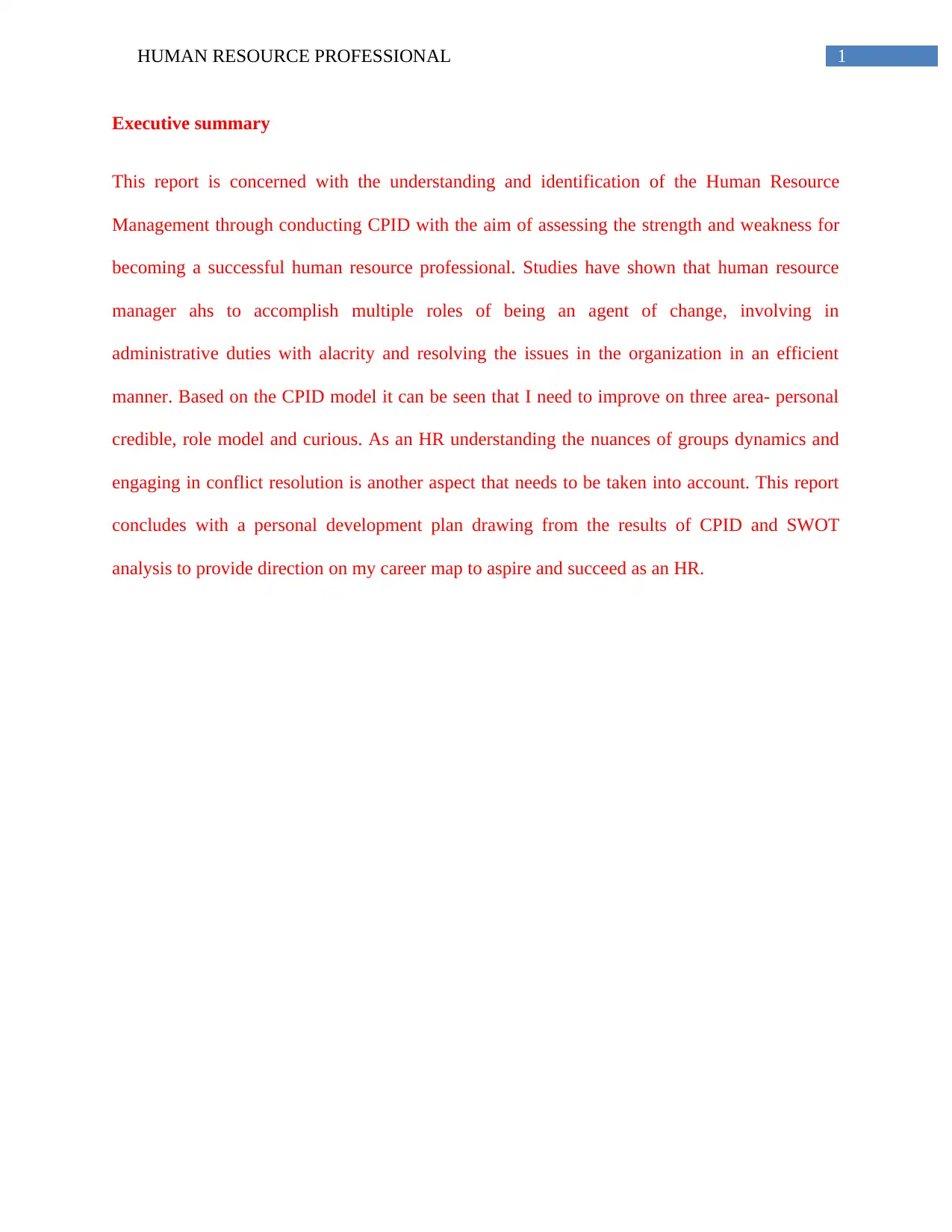
1HUMAN RESOURCE PROFESSIONAL
Executive summary
This report is concerned with the understanding and identification of the Human Resource
Management through conducting CPID with the aim of assessing the strength and weakness for
becoming a successful human resource professional. Studies have shown that human resource
manager ahs to accomplish multiple roles of being an agent of change, involving in
administrative duties with alacrity and resolving the issues in the organization in an efficient
manner. Based on the CPID model it can be seen that I need to improve on three area- personal
credible, role model and curious. As an HR understanding the nuances of groups dynamics and
engaging in conflict resolution is another aspect that needs to be taken into account. This report
concludes with a personal development plan drawing from the results of CPID and SWOT
analysis to provide direction on my career map to aspire and succeed as an HR.
Executive summary
This report is concerned with the understanding and identification of the Human Resource
Management through conducting CPID with the aim of assessing the strength and weakness for
becoming a successful human resource professional. Studies have shown that human resource
manager ahs to accomplish multiple roles of being an agent of change, involving in
administrative duties with alacrity and resolving the issues in the organization in an efficient
manner. Based on the CPID model it can be seen that I need to improve on three area- personal
credible, role model and curious. As an HR understanding the nuances of groups dynamics and
engaging in conflict resolution is another aspect that needs to be taken into account. This report
concludes with a personal development plan drawing from the results of CPID and SWOT
analysis to provide direction on my career map to aspire and succeed as an HR.
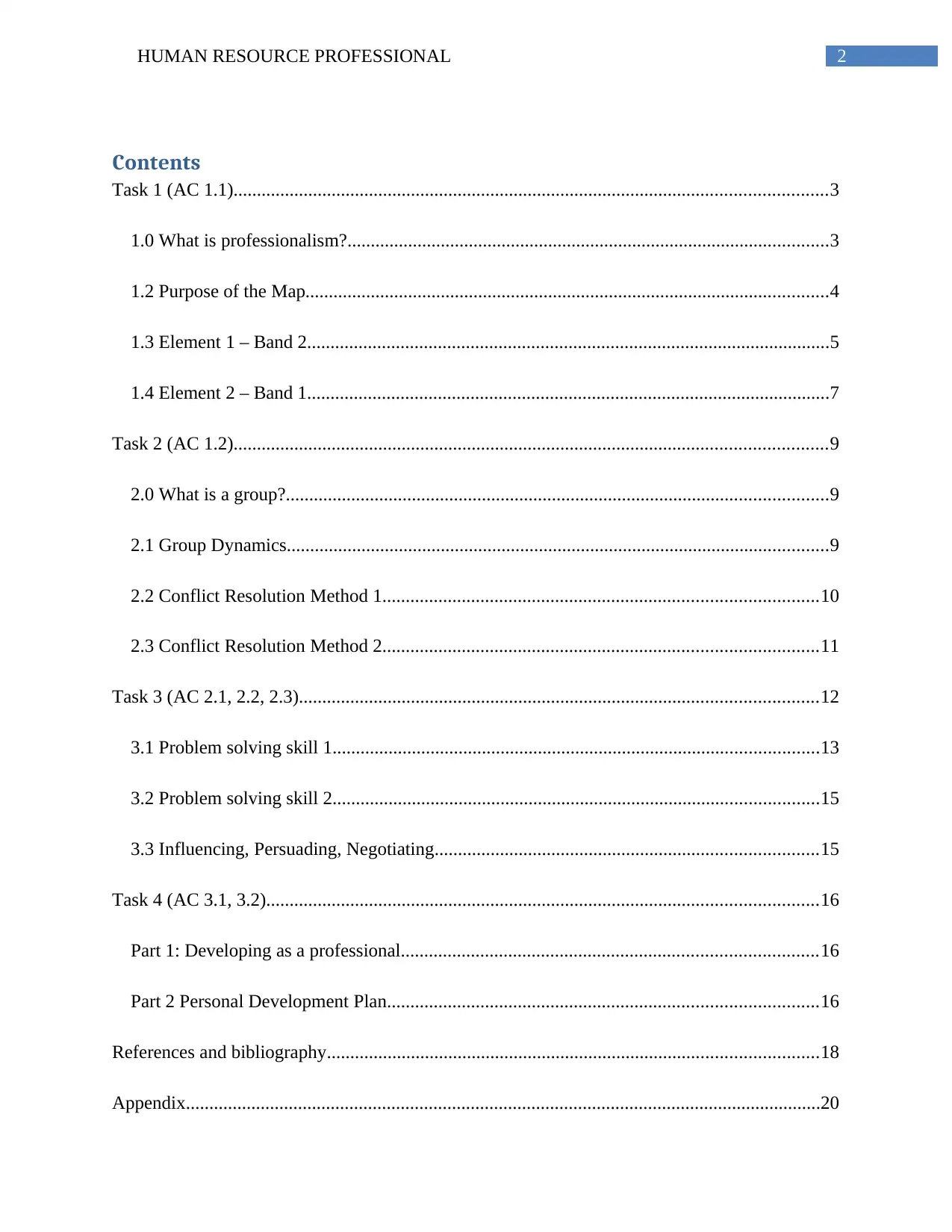
2HUMAN RESOURCE PROFESSIONAL
Contents
Task 1 (AC 1.1)...............................................................................................................................3
1.0 What is professionalism?.......................................................................................................3
1.2 Purpose of the Map................................................................................................................4
1.3 Element 1 – Band 2................................................................................................................5
1.4 Element 2 – Band 1................................................................................................................7
Task 2 (AC 1.2)...............................................................................................................................9
2.0 What is a group?....................................................................................................................9
2.1 Group Dynamics....................................................................................................................9
2.2 Conflict Resolution Method 1.............................................................................................10
2.3 Conflict Resolution Method 2.............................................................................................11
Task 3 (AC 2.1, 2.2, 2.3)...............................................................................................................12
3.1 Problem solving skill 1........................................................................................................13
3.2 Problem solving skill 2........................................................................................................15
3.3 Influencing, Persuading, Negotiating..................................................................................15
Task 4 (AC 3.1, 3.2)......................................................................................................................16
Part 1: Developing as a professional.........................................................................................16
Part 2 Personal Development Plan............................................................................................16
References and bibliography.........................................................................................................18
Appendix........................................................................................................................................20
Contents
Task 1 (AC 1.1)...............................................................................................................................3
1.0 What is professionalism?.......................................................................................................3
1.2 Purpose of the Map................................................................................................................4
1.3 Element 1 – Band 2................................................................................................................5
1.4 Element 2 – Band 1................................................................................................................7
Task 2 (AC 1.2)...............................................................................................................................9
2.0 What is a group?....................................................................................................................9
2.1 Group Dynamics....................................................................................................................9
2.2 Conflict Resolution Method 1.............................................................................................10
2.3 Conflict Resolution Method 2.............................................................................................11
Task 3 (AC 2.1, 2.2, 2.3)...............................................................................................................12
3.1 Problem solving skill 1........................................................................................................13
3.2 Problem solving skill 2........................................................................................................15
3.3 Influencing, Persuading, Negotiating..................................................................................15
Task 4 (AC 3.1, 3.2)......................................................................................................................16
Part 1: Developing as a professional.........................................................................................16
Part 2 Personal Development Plan............................................................................................16
References and bibliography.........................................................................................................18
Appendix........................................................................................................................................20
⊘ This is a preview!⊘
Do you want full access?
Subscribe today to unlock all pages.

Trusted by 1+ million students worldwide
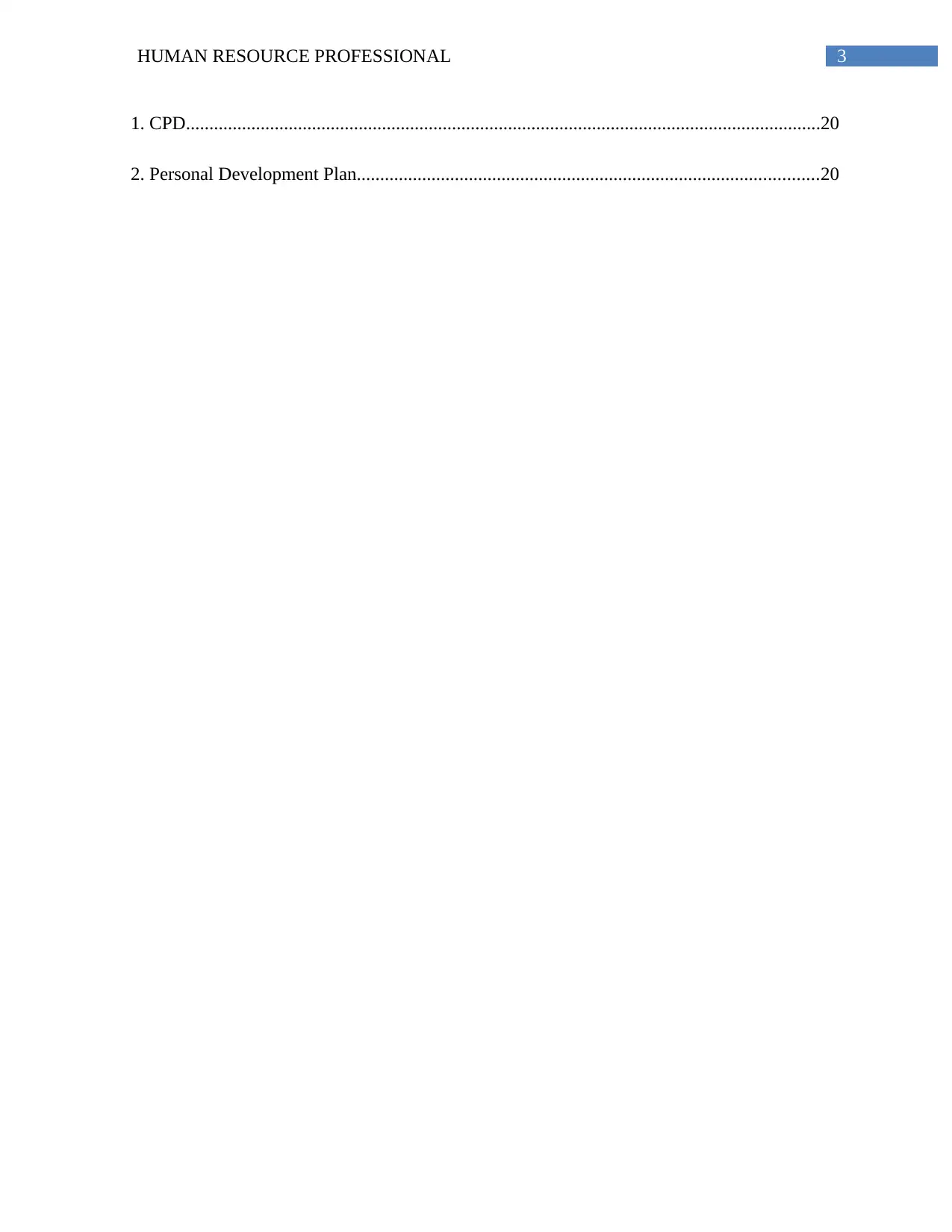
3HUMAN RESOURCE PROFESSIONAL
1. CPD........................................................................................................................................20
2. Personal Development Plan...................................................................................................20
1. CPD........................................................................................................................................20
2. Personal Development Plan...................................................................................................20
Paraphrase This Document
Need a fresh take? Get an instant paraphrase of this document with our AI Paraphraser
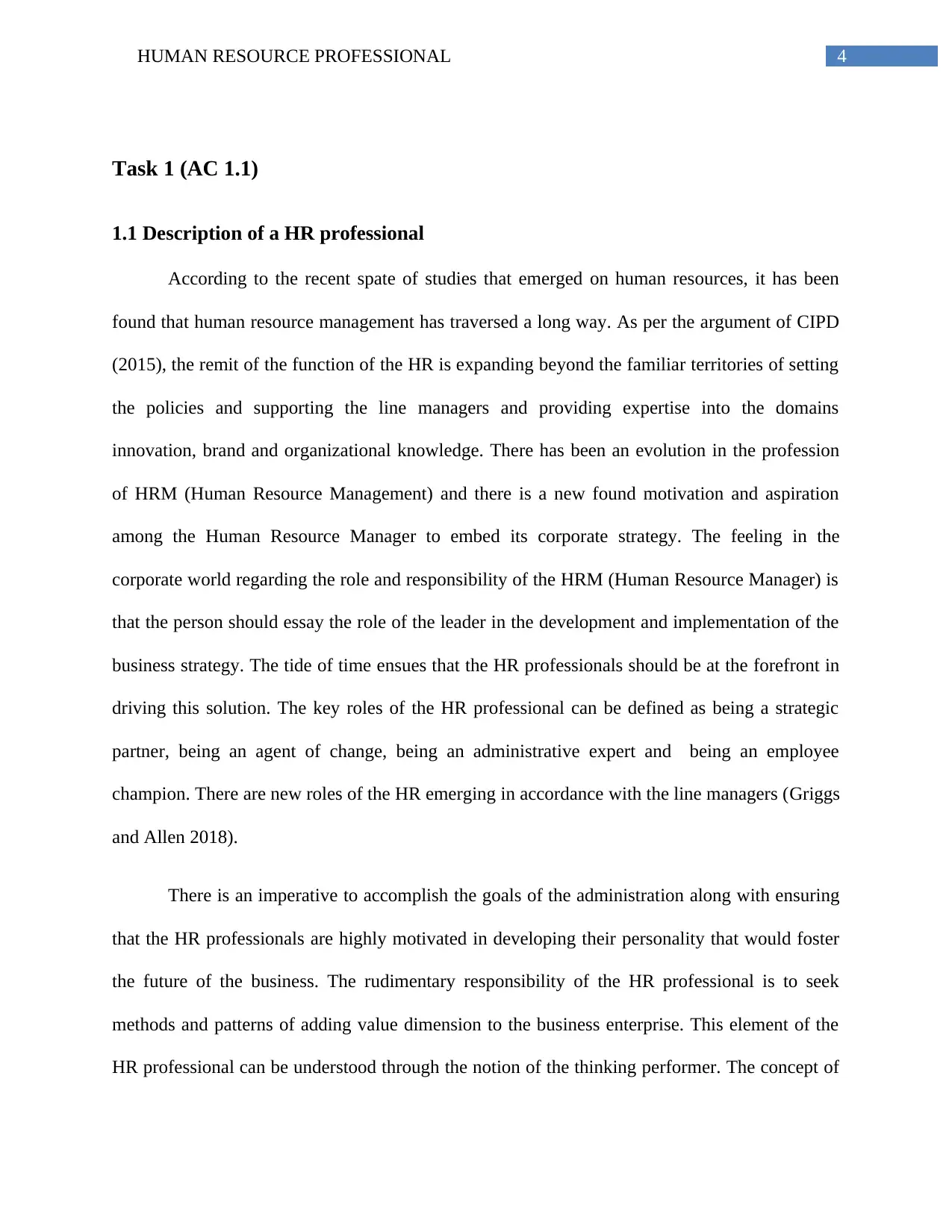
4HUMAN RESOURCE PROFESSIONAL
Task 1 (AC 1.1)
1.1 Description of a HR professional
According to the recent spate of studies that emerged on human resources, it has been
found that human resource management has traversed a long way. As per the argument of CIPD
(2015), the remit of the function of the HR is expanding beyond the familiar territories of setting
the policies and supporting the line managers and providing expertise into the domains
innovation, brand and organizational knowledge. There has been an evolution in the profession
of HRM (Human Resource Management) and there is a new found motivation and aspiration
among the Human Resource Manager to embed its corporate strategy. The feeling in the
corporate world regarding the role and responsibility of the HRM (Human Resource Manager) is
that the person should essay the role of the leader in the development and implementation of the
business strategy. The tide of time ensues that the HR professionals should be at the forefront in
driving this solution. The key roles of the HR professional can be defined as being a strategic
partner, being an agent of change, being an administrative expert and being an employee
champion. There are new roles of the HR emerging in accordance with the line managers (Griggs
and Allen 2018).
There is an imperative to accomplish the goals of the administration along with ensuring
that the HR professionals are highly motivated in developing their personality that would foster
the future of the business. The rudimentary responsibility of the HR professional is to seek
methods and patterns of adding value dimension to the business enterprise. This element of the
HR professional can be understood through the notion of the thinking performer. The concept of
Task 1 (AC 1.1)
1.1 Description of a HR professional
According to the recent spate of studies that emerged on human resources, it has been
found that human resource management has traversed a long way. As per the argument of CIPD
(2015), the remit of the function of the HR is expanding beyond the familiar territories of setting
the policies and supporting the line managers and providing expertise into the domains
innovation, brand and organizational knowledge. There has been an evolution in the profession
of HRM (Human Resource Management) and there is a new found motivation and aspiration
among the Human Resource Manager to embed its corporate strategy. The feeling in the
corporate world regarding the role and responsibility of the HRM (Human Resource Manager) is
that the person should essay the role of the leader in the development and implementation of the
business strategy. The tide of time ensues that the HR professionals should be at the forefront in
driving this solution. The key roles of the HR professional can be defined as being a strategic
partner, being an agent of change, being an administrative expert and being an employee
champion. There are new roles of the HR emerging in accordance with the line managers (Griggs
and Allen 2018).
There is an imperative to accomplish the goals of the administration along with ensuring
that the HR professionals are highly motivated in developing their personality that would foster
the future of the business. The rudimentary responsibility of the HR professional is to seek
methods and patterns of adding value dimension to the business enterprise. This element of the
HR professional can be understood through the notion of the thinking performer. The concept of
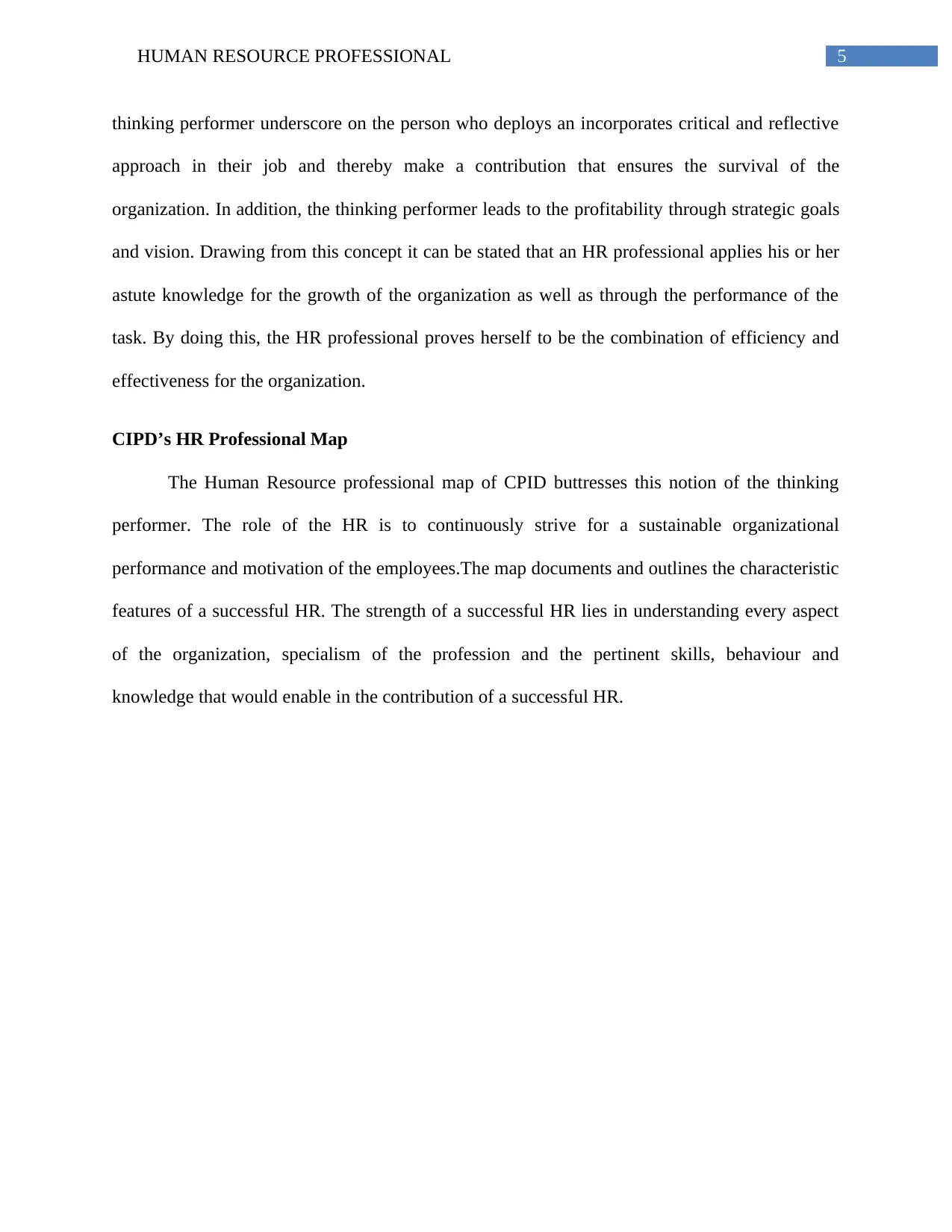
5HUMAN RESOURCE PROFESSIONAL
thinking performer underscore on the person who deploys an incorporates critical and reflective
approach in their job and thereby make a contribution that ensures the survival of the
organization. In addition, the thinking performer leads to the profitability through strategic goals
and vision. Drawing from this concept it can be stated that an HR professional applies his or her
astute knowledge for the growth of the organization as well as through the performance of the
task. By doing this, the HR professional proves herself to be the combination of efficiency and
effectiveness for the organization.
CIPD’s HR Professional Map
The Human Resource professional map of CPID buttresses this notion of the thinking
performer. The role of the HR is to continuously strive for a sustainable organizational
performance and motivation of the employees.The map documents and outlines the characteristic
features of a successful HR. The strength of a successful HR lies in understanding every aspect
of the organization, specialism of the profession and the pertinent skills, behaviour and
knowledge that would enable in the contribution of a successful HR.
thinking performer underscore on the person who deploys an incorporates critical and reflective
approach in their job and thereby make a contribution that ensures the survival of the
organization. In addition, the thinking performer leads to the profitability through strategic goals
and vision. Drawing from this concept it can be stated that an HR professional applies his or her
astute knowledge for the growth of the organization as well as through the performance of the
task. By doing this, the HR professional proves herself to be the combination of efficiency and
effectiveness for the organization.
CIPD’s HR Professional Map
The Human Resource professional map of CPID buttresses this notion of the thinking
performer. The role of the HR is to continuously strive for a sustainable organizational
performance and motivation of the employees.The map documents and outlines the characteristic
features of a successful HR. The strength of a successful HR lies in understanding every aspect
of the organization, specialism of the profession and the pertinent skills, behaviour and
knowledge that would enable in the contribution of a successful HR.
⊘ This is a preview!⊘
Do you want full access?
Subscribe today to unlock all pages.

Trusted by 1+ million students worldwide
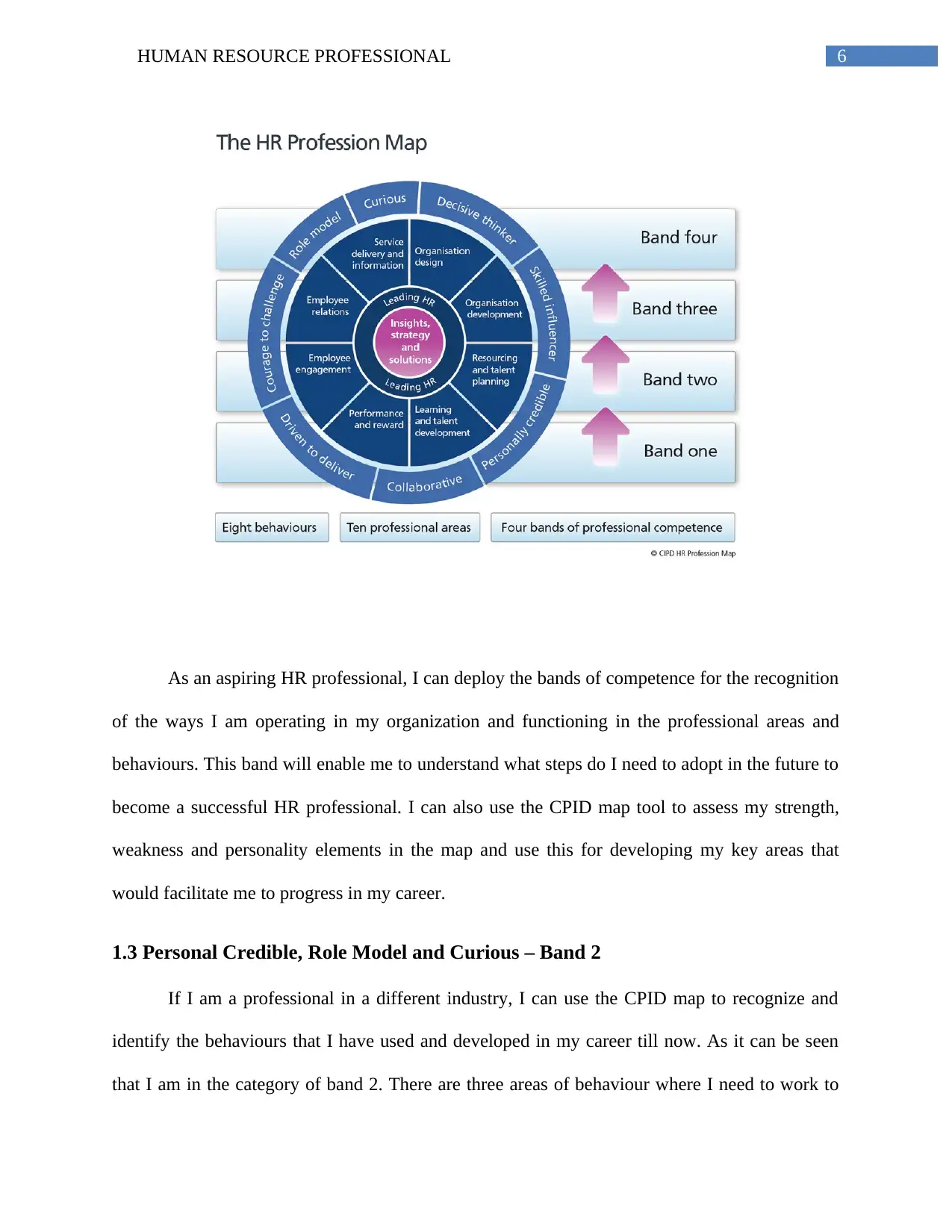
6HUMAN RESOURCE PROFESSIONAL
As an aspiring HR professional, I can deploy the bands of competence for the recognition
of the ways I am operating in my organization and functioning in the professional areas and
behaviours. This band will enable me to understand what steps do I need to adopt in the future to
become a successful HR professional. I can also use the CPID map tool to assess my strength,
weakness and personality elements in the map and use this for developing my key areas that
would facilitate me to progress in my career.
1.3 Personal Credible, Role Model and Curious – Band 2
If I am a professional in a different industry, I can use the CPID map to recognize and
identify the behaviours that I have used and developed in my career till now. As it can be seen
that I am in the category of band 2. There are three areas of behaviour where I need to work to
As an aspiring HR professional, I can deploy the bands of competence for the recognition
of the ways I am operating in my organization and functioning in the professional areas and
behaviours. This band will enable me to understand what steps do I need to adopt in the future to
become a successful HR professional. I can also use the CPID map tool to assess my strength,
weakness and personality elements in the map and use this for developing my key areas that
would facilitate me to progress in my career.
1.3 Personal Credible, Role Model and Curious – Band 2
If I am a professional in a different industry, I can use the CPID map to recognize and
identify the behaviours that I have used and developed in my career till now. As it can be seen
that I am in the category of band 2. There are three areas of behaviour where I need to work to
Paraphrase This Document
Need a fresh take? Get an instant paraphrase of this document with our AI Paraphraser
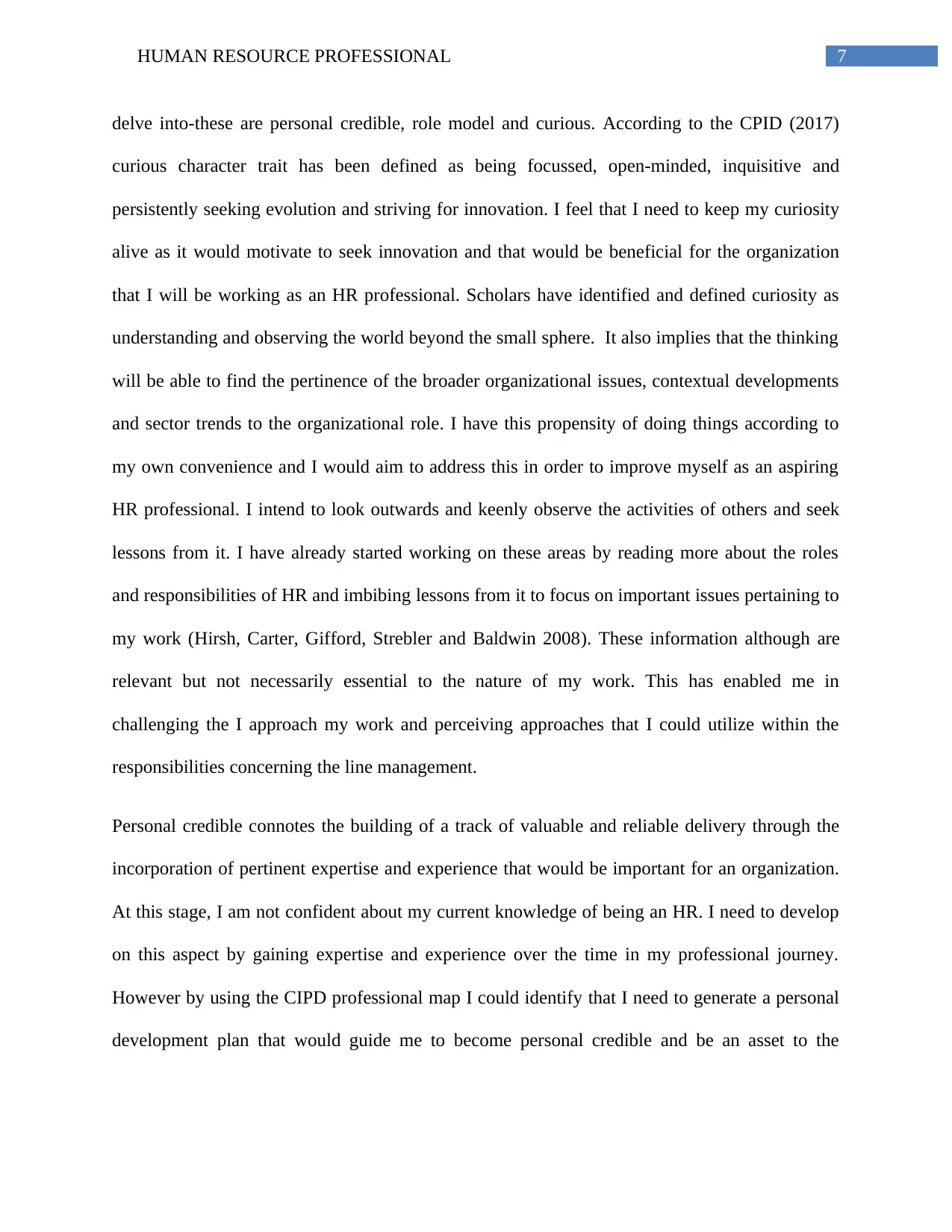
7HUMAN RESOURCE PROFESSIONAL
delve into-these are personal credible, role model and curious. According to the CPID (2017)
curious character trait has been defined as being focussed, open-minded, inquisitive and
persistently seeking evolution and striving for innovation. I feel that I need to keep my curiosity
alive as it would motivate to seek innovation and that would be beneficial for the organization
that I will be working as an HR professional. Scholars have identified and defined curiosity as
understanding and observing the world beyond the small sphere. It also implies that the thinking
will be able to find the pertinence of the broader organizational issues, contextual developments
and sector trends to the organizational role. I have this propensity of doing things according to
my own convenience and I would aim to address this in order to improve myself as an aspiring
HR professional. I intend to look outwards and keenly observe the activities of others and seek
lessons from it. I have already started working on these areas by reading more about the roles
and responsibilities of HR and imbibing lessons from it to focus on important issues pertaining to
my work (Hirsh, Carter, Gifford, Strebler and Baldwin 2008). These information although are
relevant but not necessarily essential to the nature of my work. This has enabled me in
challenging the I approach my work and perceiving approaches that I could utilize within the
responsibilities concerning the line management.
Personal credible connotes the building of a track of valuable and reliable delivery through the
incorporation of pertinent expertise and experience that would be important for an organization.
At this stage, I am not confident about my current knowledge of being an HR. I need to develop
on this aspect by gaining expertise and experience over the time in my professional journey.
However by using the CIPD professional map I could identify that I need to generate a personal
development plan that would guide me to become personal credible and be an asset to the
delve into-these are personal credible, role model and curious. According to the CPID (2017)
curious character trait has been defined as being focussed, open-minded, inquisitive and
persistently seeking evolution and striving for innovation. I feel that I need to keep my curiosity
alive as it would motivate to seek innovation and that would be beneficial for the organization
that I will be working as an HR professional. Scholars have identified and defined curiosity as
understanding and observing the world beyond the small sphere. It also implies that the thinking
will be able to find the pertinence of the broader organizational issues, contextual developments
and sector trends to the organizational role. I have this propensity of doing things according to
my own convenience and I would aim to address this in order to improve myself as an aspiring
HR professional. I intend to look outwards and keenly observe the activities of others and seek
lessons from it. I have already started working on these areas by reading more about the roles
and responsibilities of HR and imbibing lessons from it to focus on important issues pertaining to
my work (Hirsh, Carter, Gifford, Strebler and Baldwin 2008). These information although are
relevant but not necessarily essential to the nature of my work. This has enabled me in
challenging the I approach my work and perceiving approaches that I could utilize within the
responsibilities concerning the line management.
Personal credible connotes the building of a track of valuable and reliable delivery through the
incorporation of pertinent expertise and experience that would be important for an organization.
At this stage, I am not confident about my current knowledge of being an HR. I need to develop
on this aspect by gaining expertise and experience over the time in my professional journey.
However by using the CIPD professional map I could identify that I need to generate a personal
development plan that would guide me to become personal credible and be an asset to the
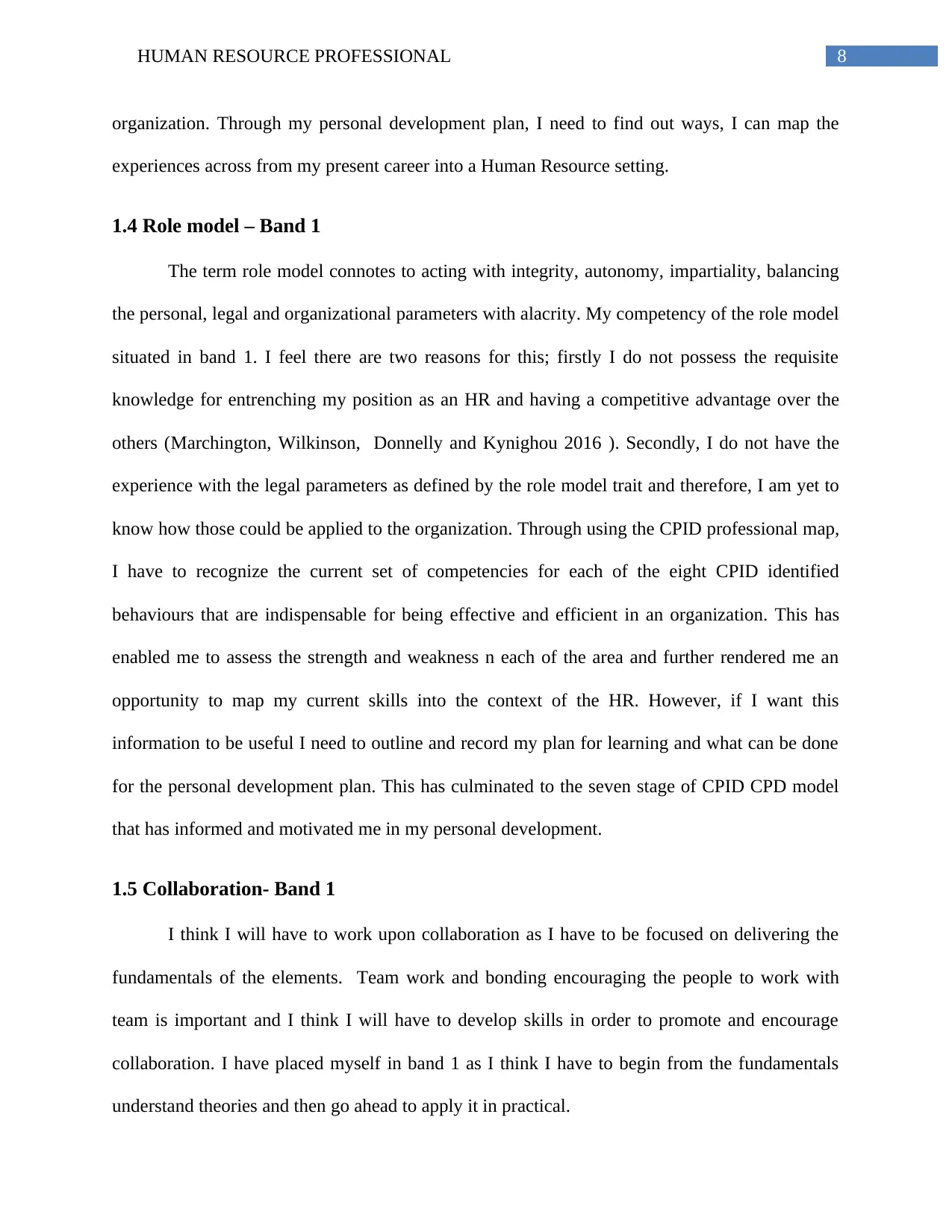
8HUMAN RESOURCE PROFESSIONAL
organization. Through my personal development plan, I need to find out ways, I can map the
experiences across from my present career into a Human Resource setting.
1.4 Role model – Band 1
The term role model connotes to acting with integrity, autonomy, impartiality, balancing
the personal, legal and organizational parameters with alacrity. My competency of the role model
situated in band 1. I feel there are two reasons for this; firstly I do not possess the requisite
knowledge for entrenching my position as an HR and having a competitive advantage over the
others (Marchington, Wilkinson, Donnelly and Kynighou 2016 ). Secondly, I do not have the
experience with the legal parameters as defined by the role model trait and therefore, I am yet to
know how those could be applied to the organization. Through using the CPID professional map,
I have to recognize the current set of competencies for each of the eight CPID identified
behaviours that are indispensable for being effective and efficient in an organization. This has
enabled me to assess the strength and weakness n each of the area and further rendered me an
opportunity to map my current skills into the context of the HR. However, if I want this
information to be useful I need to outline and record my plan for learning and what can be done
for the personal development plan. This has culminated to the seven stage of CPID CPD model
that has informed and motivated me in my personal development.
1.5 Collaboration- Band 1
I think I will have to work upon collaboration as I have to be focused on delivering the
fundamentals of the elements. Team work and bonding encouraging the people to work with
team is important and I think I will have to develop skills in order to promote and encourage
collaboration. I have placed myself in band 1 as I think I have to begin from the fundamentals
understand theories and then go ahead to apply it in practical.
organization. Through my personal development plan, I need to find out ways, I can map the
experiences across from my present career into a Human Resource setting.
1.4 Role model – Band 1
The term role model connotes to acting with integrity, autonomy, impartiality, balancing
the personal, legal and organizational parameters with alacrity. My competency of the role model
situated in band 1. I feel there are two reasons for this; firstly I do not possess the requisite
knowledge for entrenching my position as an HR and having a competitive advantage over the
others (Marchington, Wilkinson, Donnelly and Kynighou 2016 ). Secondly, I do not have the
experience with the legal parameters as defined by the role model trait and therefore, I am yet to
know how those could be applied to the organization. Through using the CPID professional map,
I have to recognize the current set of competencies for each of the eight CPID identified
behaviours that are indispensable for being effective and efficient in an organization. This has
enabled me to assess the strength and weakness n each of the area and further rendered me an
opportunity to map my current skills into the context of the HR. However, if I want this
information to be useful I need to outline and record my plan for learning and what can be done
for the personal development plan. This has culminated to the seven stage of CPID CPD model
that has informed and motivated me in my personal development.
1.5 Collaboration- Band 1
I think I will have to work upon collaboration as I have to be focused on delivering the
fundamentals of the elements. Team work and bonding encouraging the people to work with
team is important and I think I will have to develop skills in order to promote and encourage
collaboration. I have placed myself in band 1 as I think I have to begin from the fundamentals
understand theories and then go ahead to apply it in practical.
⊘ This is a preview!⊘
Do you want full access?
Subscribe today to unlock all pages.

Trusted by 1+ million students worldwide
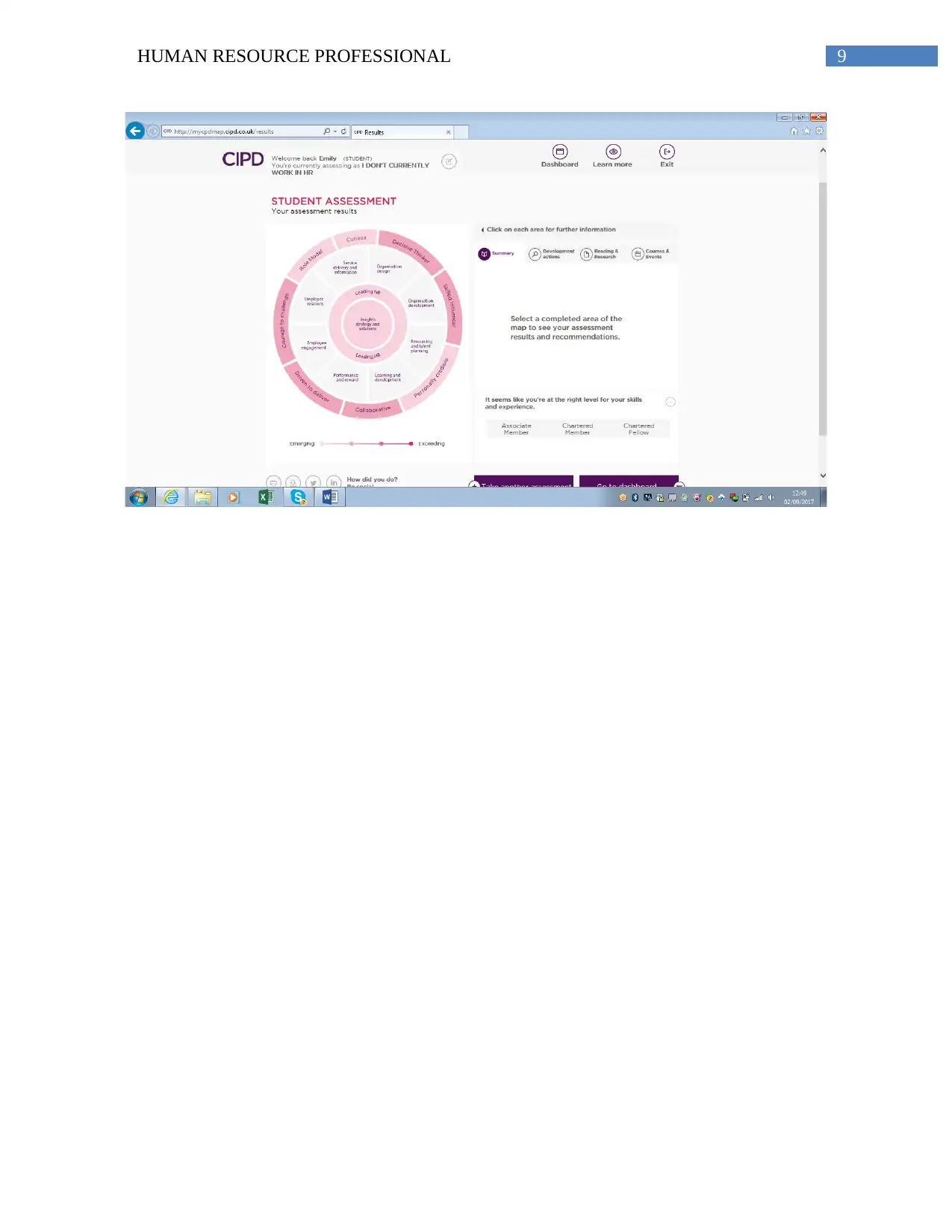
9HUMAN RESOURCE PROFESSIONAL
Paraphrase This Document
Need a fresh take? Get an instant paraphrase of this document with our AI Paraphraser
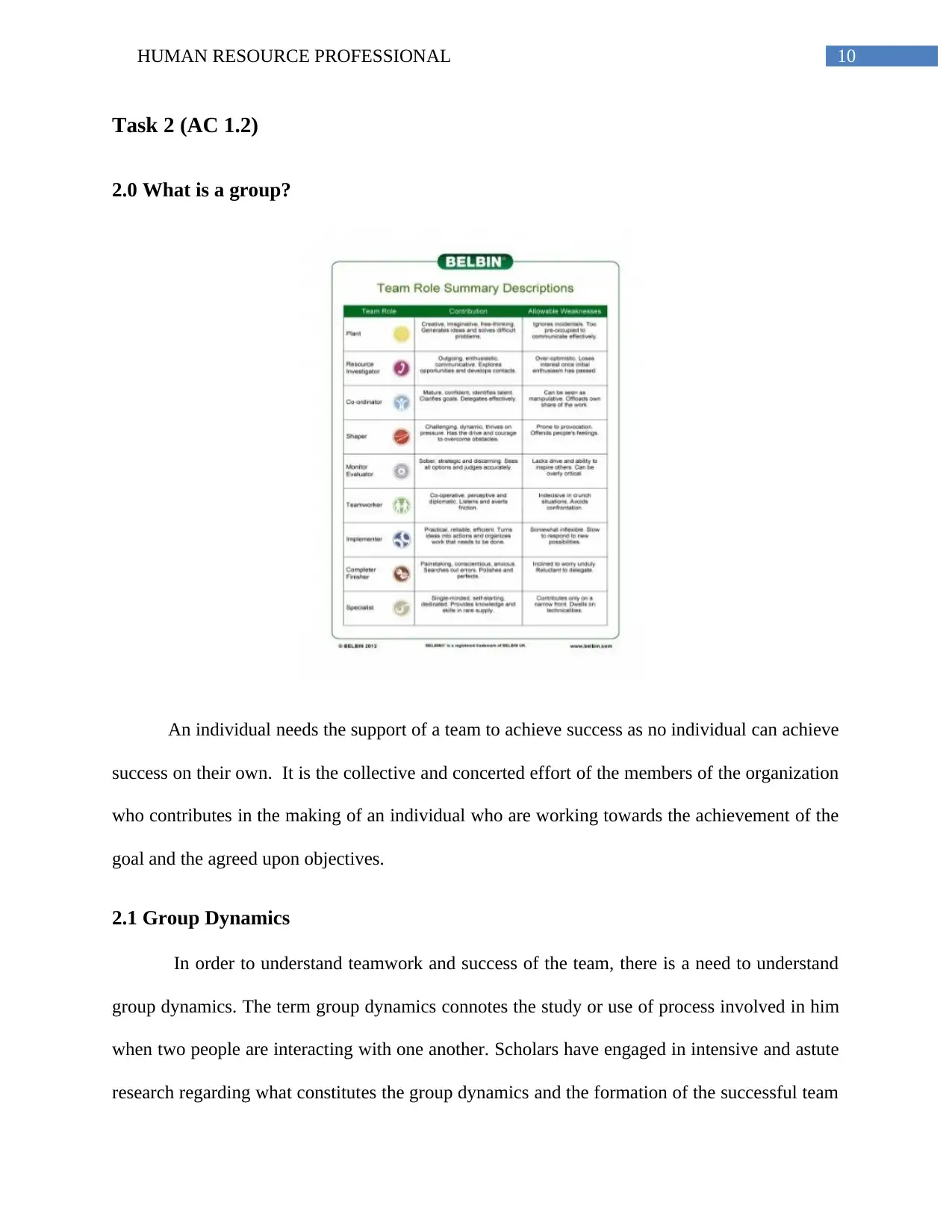
10HUMAN RESOURCE PROFESSIONAL
Task 2 (AC 1.2)
2.0 What is a group?
An individual needs the support of a team to achieve success as no individual can achieve
success on their own. It is the collective and concerted effort of the members of the organization
who contributes in the making of an individual who are working towards the achievement of the
goal and the agreed upon objectives.
2.1 Group Dynamics
In order to understand teamwork and success of the team, there is a need to understand
group dynamics. The term group dynamics connotes the study or use of process involved in him
when two people are interacting with one another. Scholars have engaged in intensive and astute
research regarding what constitutes the group dynamics and the formation of the successful team
Task 2 (AC 1.2)
2.0 What is a group?
An individual needs the support of a team to achieve success as no individual can achieve
success on their own. It is the collective and concerted effort of the members of the organization
who contributes in the making of an individual who are working towards the achievement of the
goal and the agreed upon objectives.
2.1 Group Dynamics
In order to understand teamwork and success of the team, there is a need to understand
group dynamics. The term group dynamics connotes the study or use of process involved in him
when two people are interacting with one another. Scholars have engaged in intensive and astute
research regarding what constitutes the group dynamics and the formation of the successful team
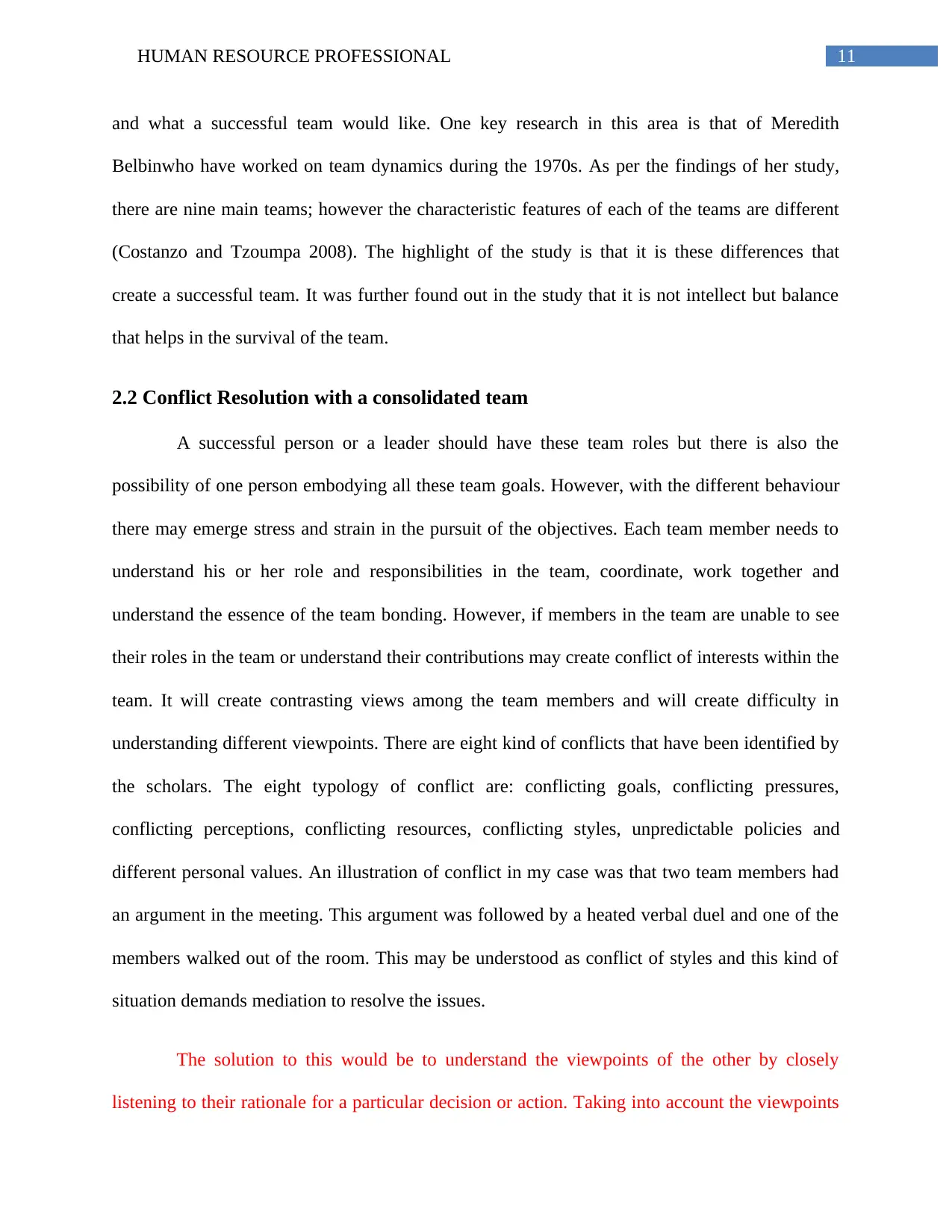
11HUMAN RESOURCE PROFESSIONAL
and what a successful team would like. One key research in this area is that of Meredith
Belbinwho have worked on team dynamics during the 1970s. As per the findings of her study,
there are nine main teams; however the characteristic features of each of the teams are different
(Costanzo and Tzoumpa 2008). The highlight of the study is that it is these differences that
create a successful team. It was further found out in the study that it is not intellect but balance
that helps in the survival of the team.
2.2 Conflict Resolution with a consolidated team
A successful person or a leader should have these team roles but there is also the
possibility of one person embodying all these team goals. However, with the different behaviour
there may emerge stress and strain in the pursuit of the objectives. Each team member needs to
understand his or her role and responsibilities in the team, coordinate, work together and
understand the essence of the team bonding. However, if members in the team are unable to see
their roles in the team or understand their contributions may create conflict of interests within the
team. It will create contrasting views among the team members and will create difficulty in
understanding different viewpoints. There are eight kind of conflicts that have been identified by
the scholars. The eight typology of conflict are: conflicting goals, conflicting pressures,
conflicting perceptions, conflicting resources, conflicting styles, unpredictable policies and
different personal values. An illustration of conflict in my case was that two team members had
an argument in the meeting. This argument was followed by a heated verbal duel and one of the
members walked out of the room. This may be understood as conflict of styles and this kind of
situation demands mediation to resolve the issues.
The solution to this would be to understand the viewpoints of the other by closely
listening to their rationale for a particular decision or action. Taking into account the viewpoints
and what a successful team would like. One key research in this area is that of Meredith
Belbinwho have worked on team dynamics during the 1970s. As per the findings of her study,
there are nine main teams; however the characteristic features of each of the teams are different
(Costanzo and Tzoumpa 2008). The highlight of the study is that it is these differences that
create a successful team. It was further found out in the study that it is not intellect but balance
that helps in the survival of the team.
2.2 Conflict Resolution with a consolidated team
A successful person or a leader should have these team roles but there is also the
possibility of one person embodying all these team goals. However, with the different behaviour
there may emerge stress and strain in the pursuit of the objectives. Each team member needs to
understand his or her role and responsibilities in the team, coordinate, work together and
understand the essence of the team bonding. However, if members in the team are unable to see
their roles in the team or understand their contributions may create conflict of interests within the
team. It will create contrasting views among the team members and will create difficulty in
understanding different viewpoints. There are eight kind of conflicts that have been identified by
the scholars. The eight typology of conflict are: conflicting goals, conflicting pressures,
conflicting perceptions, conflicting resources, conflicting styles, unpredictable policies and
different personal values. An illustration of conflict in my case was that two team members had
an argument in the meeting. This argument was followed by a heated verbal duel and one of the
members walked out of the room. This may be understood as conflict of styles and this kind of
situation demands mediation to resolve the issues.
The solution to this would be to understand the viewpoints of the other by closely
listening to their rationale for a particular decision or action. Taking into account the viewpoints
⊘ This is a preview!⊘
Do you want full access?
Subscribe today to unlock all pages.

Trusted by 1+ million students worldwide
1 out of 26
Related Documents
Your All-in-One AI-Powered Toolkit for Academic Success.
+13062052269
info@desklib.com
Available 24*7 on WhatsApp / Email
![[object Object]](/_next/static/media/star-bottom.7253800d.svg)
Unlock your academic potential
Copyright © 2020–2025 A2Z Services. All Rights Reserved. Developed and managed by ZUCOL.





![5DVP: Developing Professional Practice Report - [University Name]](/_next/image/?url=https%3A%2F%2Fdesklib.com%2Fmedia%2Fimages%2Frq%2Fd1f1fed29d4c4b72b622be5f5f3b52cf.jpg&w=256&q=75)